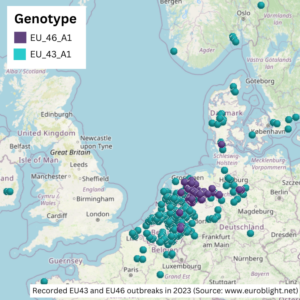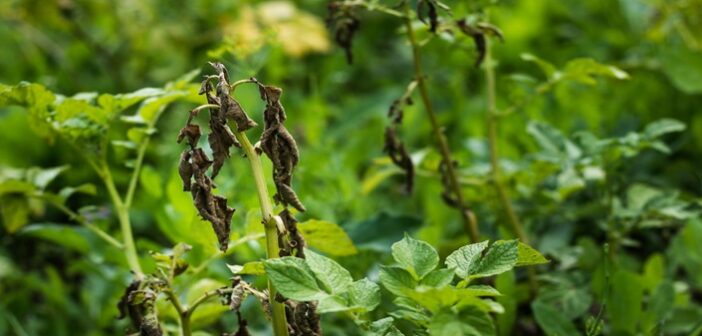With the rise of strains resistant to vital chemistry on the continent, potato blight control could face a challenging season ahead.
EU_43_A1 (EU43) remains undetected in the UK, although it has now been found in Ireland. This strain and an additional related strain, EU_46_A1 (EU46), account for almost 40% of the samples analysed across Europe by EuroBlight, a consortium of organisations studying late blight across Europe.
In 2022, EU43 primarily concerned Danish growers, but it has spread to become the dominant strain in the Netherlands (52%), Germany (52%), and Belgium (36%) in 2023.
Fortunately, the frequency of EU43 in Denmark fell from 64% in 2022 to 24% in 2023, indicating a potential fitness penalty and that the sensible use of carboxylic acid amide (CAA) fungicides can reduce the selection pressure for this strain.
“We analysed 946 samples last year, and there is still no EU43, which is good news,” says Dr David Cooke, research leader at the James Hutton Institute. Dr Cooke and Dr Alison Lees lead the team running the Fight Against Blight monitoring service, which is enabled by industry sponsors and is still seeking funding to run this season’s service.
 “In the UK, we mostly have EU_36_A2. This doesn’t mean blight is easy to manage, but at least we don’t have resistance issues. All the fungicide testing has shown that the UK isolates are sensitive to all the main actives, apart from the known fluazinam issue with EU_37_A2,” adds Dr Cooke.
“In the UK, we mostly have EU_36_A2. This doesn’t mean blight is easy to manage, but at least we don’t have resistance issues. All the fungicide testing has shown that the UK isolates are sensitive to all the main actives, apart from the known fluazinam issue with EU_37_A2,” adds Dr Cooke.
The learnings from the continent continue to resonate, according to Dr Cooke. There, mandipropamid and oxathiapiprolin resistance exists and is widespread in the case of mandipropamid.
It is still debated whether the level of resistance amongst the CAA fungicides varies. Regardless, experts caution that CAA-containing fungicides should be used judiciously and that the FRAC CAA working group guidelines are rigorously followed.
“If we do find EU43 (in the UK), the first thing we will need to do is test what variant of the lineage it is and whether it has the resistance or not. There are variants of EU43 which are sensitive to mandipropamid and oxathiapiprolin, and some which are resistant to both,” says Dr Cooke.
The James Hutton Institute has been developing genetic markers for mandipropamid and oxathiapiprolin resistance as part of Scottish government funding. Dr Cooke anticipates that they will be able to use these to determine whether any field samples of EU43 in the 2024 season have the mutations associated with fungicide resistance.
“The EU43 found in Ireland is a concern because of the prevailing wind. Our view is once it has been found, there must be others; they just haven’t been sampled.
“Early potato crops in Pembrokeshire and Cornwall will be of interest and should be monitored closely,” adds Dr Cooke.
Agronomist Denis Buckley of Highfield Lodge Agronomy is principally concerned about imported seed potatoes bringing EU43 and EU46 into the UK.
A 7% reduction in the Northern Europe seed area in 2023, coupled with losses from downgrading and poor yield, means there will be a critical shortage of potato seed this season. There is a danger that supply problems could see seed potatoes from crops infected with EU43 or EU46 imported into the UK.
“Imported seed is more of a potential issue than anything else,” says Mr Buckley. “I have been advising my clients not to buy it, but the problem is that many are already committed and can’t source it from anywhere else.”
Dr Cooke agrees this is a risk and cites infected seed as the most likely cause of EU37 arriving in the UK because it was first detected in a distinctive node in the Midlands. “I can’t remember the uncertainty surrounding blight control being this great,” continues Denis. “The resistance that has appeared is in very important chemistry.
“This puts more resistance pressure on the other active ingredients that are still available. Then there is then a risk that they fall over too.”
Mr Buckley is still figuring out a robust programme of systemic fungicides for the season. “Whatever programme I go with, mancozeb will be a large part of it. You need to be applying mancozeb, certainly in the first half of the season, with every spray.
“You don’t know what will turn up on your farm, and the last thing you want is blight.” Mancozeb is the only potato blight fungicide we have access to with true multisite activity, meaning selection for resistance is highly unlikely,” adds Denis.
The regulatory outlook for mancozeb
At present, the proposed withdrawal timelines would mean the sale and supply of any plant protection product containing mancozeb ends on October 31st this year, says Geoff Hailstone, potato technical lead for UPL in the UK.
An additional year would be allowed for the storage, disposal and use of any product containing mancozeb. This means that growers should plan their purchases and usage accordingly to avoid any disruptions to their planned blight programmes.
Mr Hailstone believes the loss of mancozeb in mainland Europe has been an important contributory factor in the increase in resistant strains, which has resulted in serious blight outbreaks, leading to yield and quality losses.
UPL plans to have Nautile DG (cymoxanil + mancozeb) and Manzate 75 WG (mancozeb) available this year. “We are planning our production for mancozeb based on it being approved for sale this season,” explains Geoff. “The UPL team is busy asking the market how much mancozeb they are likely to need and whether this is more or less than last year.
“The industry is coming off the back of a high-pressure year in 2023 and increasing concerns over resistance pressure. It is difficult to ascertain what a typical season is.
“I would encourage growers and advisors to speak with their suppliers to let them know what they expect to need. This information greatly helps with our production planning.”
He advises potato growers to continue to adhere to the general FRAC guidance. Always mix products with different modes of action in the same application and alternate mixes in the programme.
“Without mancozeb, products like Proxanil (cymoxanil + propamocarb) would become even more important. The two actives in Proxanil have no reported resistance issues; they are both from different chemistry groups and are the only members of those groups.
“Cymoxanil is known to be one of the few actives with kickback activity and has a very low risk of developing resistance. Propamocarb has strong anti-sporulant activity, good movement in the plant and is only active in the carbamate resistance group.
“When tank-mixed with a protectant fungicide such as cyazofamid, Proxanil strengthens the activity and gives excellent resistance management.”




